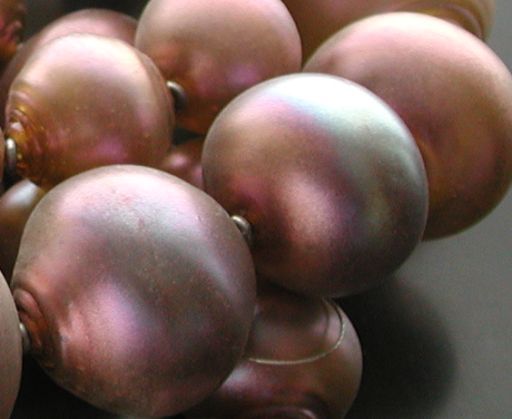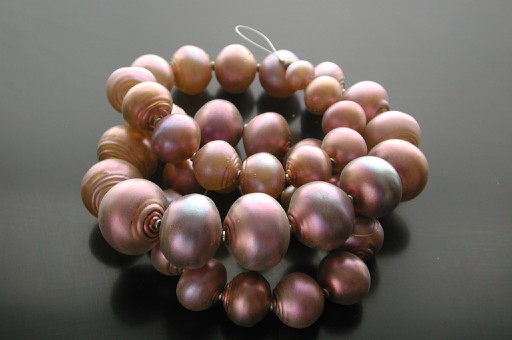What I offered to make in exchange was a string of “Tiffany favrile style glass” beads using a pixie dust coating. The collector who wanted them seemed very inclined to give me a lot of latitude—plenty of time to make them, and “no stress”, which I interpreted to mean to follow my artistic impulses, as opposed to rigidly following the original specifications.
Not too far past the temperature at which pixie permanently sticks, it burns and turns to ugly grey scum. Between not sticking and burning is the happy medium, and closer to the nasty grey scum end of this narrow range, one can get iridescent effects. So my wide creative latitude encouraged me to “push” the pixie dust more than I'm typically willing to do.
The other decision I made was to use PIG glass. This stuff, which comes from India, and stands for “Perfect International Glass” is cheap—about five dollars a pound—and truly horrible. I've told any number of aspiring beadmakers that if they really want to learn how to handle tricky glass, this is the stuff to start out with, because it does everything—it boils; it spits; it's incompatible with other colors in the pallette; it's full of seeds and stones; and did I mention it spits?
Given that it took me anywhere from two to four times (I found I was happier if I didn't keep precise track) to make a bead with this stuff than normal, well-behaved stuff, and knew it would be a pain, I chose it precisely because it had the seeds and particularly because it comes in a muddy golden green color simply not available in the much more cleanly manufactured glasses. I wanted that antique look and color it would give. I certainly didn't save any money. Then I looked up favrile, confirmed that my memory was fairly close, and set out to make beads.
The glass was truly horrible. Bad as the pieces of flying frit were, I particularly disliked its nasty habit of spitting molten chunks up to 12mm long onto my brand-new hardwood floor. Granted, it is a cheap hardwood floor, because I knew it would get scorched. But I'd never had glowing orange chunks dance off the end of rod to land on the floor before! About this time, when I was truly wondering what I could've ever been thinking to accept this commission, the collector sent me a very nice letter, stating s/he was very looking forward to the beads, to take as long as needed to make them perfectly shaped, round, and matched.
I'm all for perfection, but there's just one tiny little problem: I can't do it. Never have. In fact, I more or less decided in college that I simply didn't have the talent to justify the kind of obnoxious behavior perfectionists often inflict on the world, and decided to attempt to be good, rather than almost certainly fail at being great. Perhaps some day I will nevertheless make “perfect” beads, but at this point, I merely try to do my best. In fact, one of the nice things about beadmaking is that you can always try again, like the Japanese calligrapher's practice of a single character, over and over and over. Fortunately, I was most of the way through the project, well past the point of even considering doing it over, so I decided to finish up, send an apologetic letter offering to send the beads I had traded for back if mine were unacceptable, and insured that puppy with an approximate 90% “I'll-never-ever-make-this-again-surcharge” because nothing less would even make me consider making those beads again if they got lost or damaged in shipping.
A couple of weeks after I sent the package registered mail, (I really didn't want it to get lost) I got a phone call from the recipient, delighted with the beads.
Only problem was, s/he wanted more.
update: added tag(s), re-input 2nd image, added date of directory. 05oct17; changed tag, 25may2018
Unless otherwise noted, text, image and objects depicted therein copyright 1996--present sylvus tarn.
Sylvus Tarn
